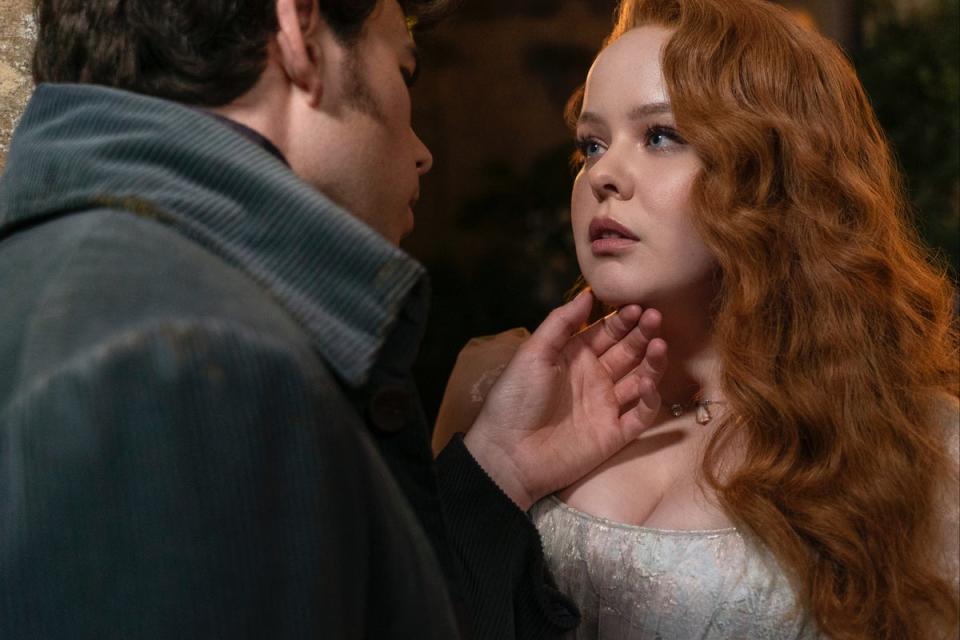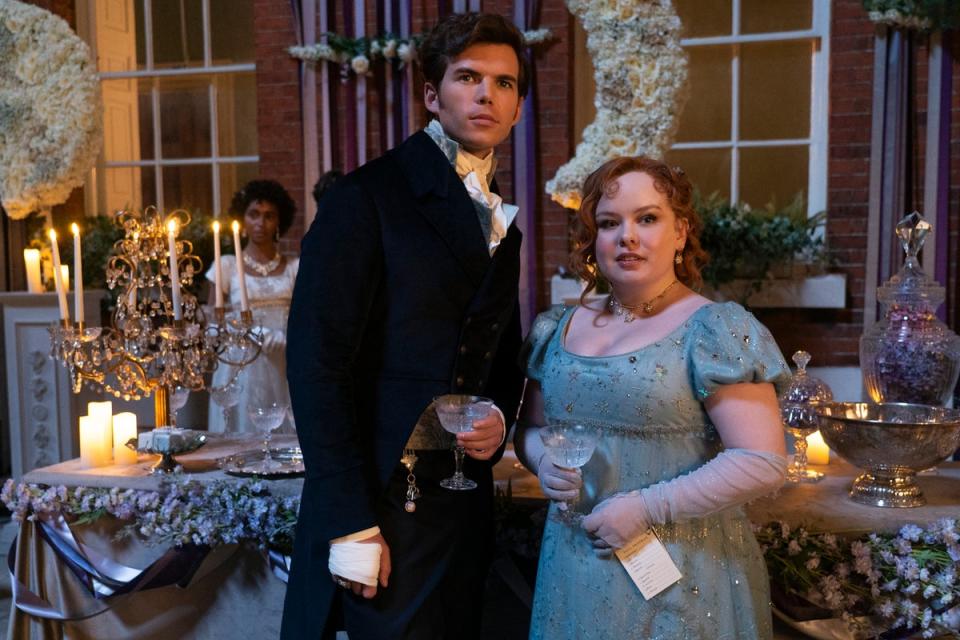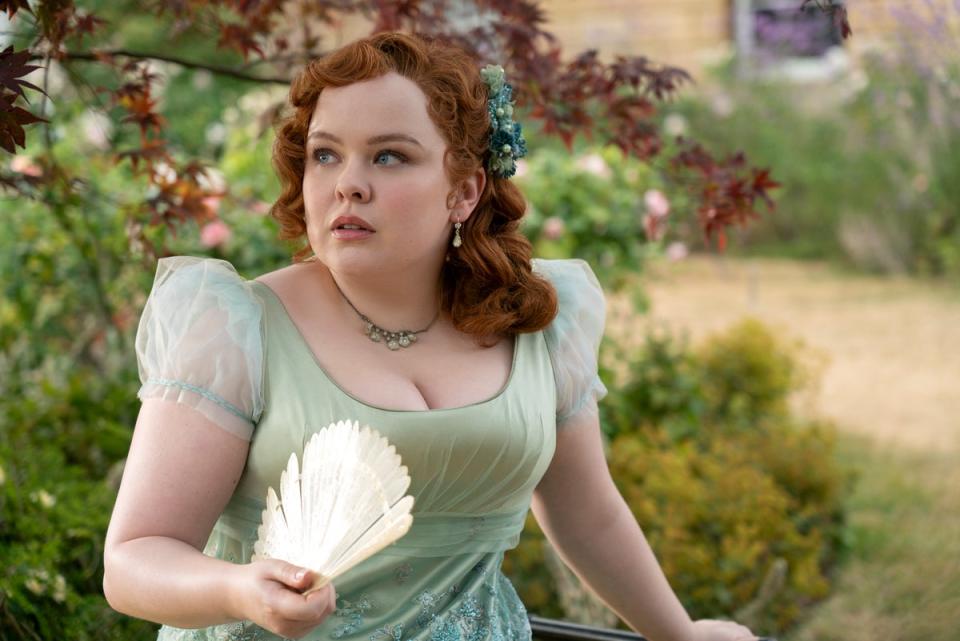How accurate is the sex in Bridgerton season three? Historians share what it was really like in Regency era

- Oops!Something went wrong.Please try again later.
- Oops!Something went wrong.Please try again later.
Dearest readers, a new season of Bridgerton has finally hit streaming platforms, with viewers once again finding themselves yearning for a Regency-era romance.
The first four episodes of Bridgerton season three debuted on Netflix on May 16, with new budding love interests at the center of the drama: Penelope Featherington (Nicola Coughlan) and Colin Bridgerton (Luke Newton).
This season, Penelope – the anonymous author (spoiler alert) behind the show’s gossip pamphlet, Lady Whistledown – is intent on finding a husband, so that she may live her life freely and away from the confines of her often mortifying Featherington family. Colin, fresh from his grand tour of Europe, offers to play “marriage whisperer” for his old friend by giving her lessons on love.
However, their innocent efforts unexpectedly take a turn once Colin begins to learn his feelings for Penelope – who has always harbored a secret crush on the third oldest Bridgerton – are more than just platonic.
As fans eagerly awaited the arrival of Bridgerton season three, much of the excitement swirled around the inevitable sex scenes that would be depicted in the Shonda Rhimes-led period piece. In 2020, when Bridgerton debuted on Netflix during a touch-starved lockdown, the show instantly became a smash hit for its steamy scenes between the Duke of Hastings (Regé-Jean Page) and Daphne Bridgerton (Phoebe Dynevor). While the show’s second season contained considerably less sex scenes, the palpable tension between Kate Sharma (Simone Ashley) and Anthony Bridgerton (Jonathan Bailey) sent viewers into levels of yearning unlike ever before.

Unfortunately, fans must wait until the second installment of season three if they wish to see more of Bridgerton’s signature sex scenes. While the first four episodes contained a brief moment of oral sex between newlyweds Kate and Anthony, and a horse-drawn carriage fondling between Penelope and Colin, season three was comparatively deficient in copulation.
But perhaps, that’s what makes season three more historically accurate than seasons past. While the series takes place during Regency Era England – a period of change and development lasting from 1811 to 1820 – Bridgerton creators Rhimes and Chris Van Dusen still take many creative liberties in order to reflect modern society. But how well do they depict what sex was actually like in Regency England?
Speaking to The Independent, Lesley A Hall – a former archivist at the Wellcome Library in London and a historian on gender and sexuality in the 19th and 20th centuries – revealed that Bridgerton is rather a romanticized version of what intimacy was actually like during that time period. Indeed, many relationships between men and women of the Ton were intended to secure a financial match.
“There are all sorts of compromises going on within elite aristocratic circles, where people recognize that you’ve got to marry for financial reasons and not necessarily for love or for a certain kind of affection,” Hall told The Independent.
As a result, there were many restrictions placed on women in society, so as to not sully their prospects for finding a husband. Hall explained that young eligible women were meant “to be virginal” and “pure”. The strict rules of courtship during the Regency era meant that men and women must always be chaperoned, so as to safeguard her reputation.

“They’ve got to be because producing an heir to the right husband, they are not meant to be knocked up before marriage by somebody else,” she said. “There was also a whole lot of superstition about if they’ve even had another man, that might convey some kind of effect on them.”
Although these antiquated ideals about women would persist well into the 20th century (and even in some places, today), historians view the Georgian period – which includes the Regency era – as somewhat of a “sexual revolution” throughout Britain. Ideas about sex became more secular, rather than influenced by the Church, and discussions about extramarital sex, pornography, and same-sex relationships permeated throughout the period’s visual culture. By 1750, most forms of consensual extramarital sex had already been legalised in Britain with the exception of homosexuality. Although, even English philosophers like Jeremy Bentham argued for the decriminalization of sodomy.
Fortunately for women, some of these changes also included changing attitudes toward female sexual pleasure.

“There was a shift going on from the idea that both men and women have equal lust, and even that women are possibly more lustful than men. There was an increasing idea that women are more pure, but they actually have to contain the dangerous powers of sexuality; that women need to have orgasms to conceive; that sexual pleasure for both sexes is necessary for reproduction,” said Hall. “Whether, of course, it was being discussed in these elite circles, as opposed to a more radical, lower middle class is a whole different thing. There were all sorts of communities within elite circles who were mingling with intellectuals and radicals, so you can’t say these ideas aren’t percolating.”
That’s why it initially came as a shock to viewers in season one of Bridgerton when protagonist Daphne was utterly clueless about sex and reproduction. This was echoed once again in season three, when Penelope’s sisters – who are in a race to produce an heir to the Featherington fortune (or, whatever is left of it) – proved they don’t know very much about sex at all.
Hall admitted that it’s quite possible that some women in high society shied away from discussions about sex, let alone female pleasure. While Hall cited the popular 1684 pamphlet Aristotle’s Masterpiece, which provided a manual on sex, pregnancy, and childbirth, a total unawareness about sex wasn’t necessarily the norm.
“There might’ve been young girls who would be kept very chaste by their parents, but they might have also heard from servants, picked things up in their father’s library, or their brothers might have told them,” she said.
As for the men in Bridgerton, who are often seen parading around brothels, the sexual proclivities of men in the Regency era was very much the same. “Men were very free to have mistresses, go to brothels, seduce other men’s wives,” Hall said. However, the show’s characters seem a little too laid-back when it comes to contraception. Should season three viewers simply assume that Colin donned a sheep-gut condom when he had a threesome with two women in episode two?
“Sheep-gut condoms from about the early 19th century would have probably been used as a protective against venereal disease at that period,” Hall said. Made out of the intestines of sheep, this popular form of contraception included soaking, drying, and fastening with a ribbon. “We could hope that the young men were practicing safe sex, but they were probably rather more reckless.”
Are fans tuning into Bridgerton each season for the show’s historical accuracy and real-life depiction of the Regency era? Most likely, no. It’s safe to say that the fashion, sex, and romanticized vision of courtship is what entices viewers to log into their parents’ Netflix account and binge watch Bridgerton. But just because the series may not be entirely accurate, especially when it comes to its depiction of intimacy, that doesn’t mean that fans can’t enjoy it just the same.
“It’s not necessarily the truth, the whole truth, and nothing but the truth, but it’s not necessarily a complete lie either. Sometimes you need good, nice stories. We don’t always want the grim, miserable stories,” said Hall. “People did have happy marriages. People did fall in love. People did marry the people they wanted to, rather than somebody they didn’t want to. There’s nothing wrong with having fun.”
The first four episodes of Bridgerton season three are available to stream on Netflix. The final four episodes will be released on June 13.

